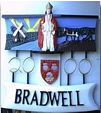Mrs Daisy Newnham lived in Bradwell from 1919 until her death in January 2012. In 1993, she published her book, which in 2008 she kindly allowed ‘The Bradwellian’ to serialise – it was featured in twelve editions of the publication, between October 2008 and March 2016. After Daisy’s death, the serialisation continued with kind permission from her family – an obituary for her was included in the March 2012 edition of the publication.
Bradwell, starting at Browston Corner, along Turnpike Road, leading from Beccles to Gt Yarmouth. Open fields until we reach Clay Lane on the right. A few wooden bungalows built in the early 1900’s. Mr Newark, Mrs Macdonald, Mrs Buckley lived in these. This lane leads to Wheatcroft Farm and Hobland Hall, built around 1839, owned by Mrs and Mrs Lark. Travelling along Beccles Road, the Council Allotments have been there since the early 1900’s. Our fathers were charged £1 a year for 20 rod until after the War, when they went up to £3. The first house on the right at the corner of Green Lane is called Cherry Dene and was owned by Mr Postman Bailey, who owned most of the land to the Village Green. He was the last man to pay tithes to the Bradwell Church.
Next are two cottages called Hawthorn Cottages, where Mr Moore and Mr and Mrs Long lived in the 1930’s. The large house next was an Off Licence before the turn of the Century. It has a large cellar underneath where the wines were kept supplied by Steward and Patterson. This has changed hands several times. A Mrs Smith lived there in the 1930’s, Mrs Bowls, Dugdale, Mills, Mr Burt and now Mr and Mrs Fitzgerald. This house is called Sunnyside.
Next comes Prince of Wales Terrace, a row of 6 houses, then a row of 10 called Harleston Terrace, these were built about 1847. They were sometimes called Gipsy Green cottages. There was a 23 foot opening between the two rows leading to the Green at the back of the houses. The two brick buildings still standing at the bottom of no 11 and 12 were a Blacksmith’s and Wheelwright’s once owned by Mr Rivitt, Mr Wright and Cooper. These were closed down about 1889, the same time as the Off Licence. These buildings were turned into garages in the 1960’s.
Most of the houses were owned by Mrs Bland of Belton New Road, and Mr Burton of Burton’s Farm, and Mr Berry the Baker of Belton. I have lived in one of Mr Burton’s houses since 1919. Mrs Brighton, his niece, died in 1982 in the adjoining one. From the green at the back of these houses, stretching down to Sun Lane, was all farmland owned by Wright, Rivitt, Bland and Burton in 1848. In 1870, most of the land was sold in 62 lots at the Star Hotel, Great Yarmouth, to Gresimus Woods, who lived in one of these houses, and agreed with Mr Robert Sayer, who owned part of the green, that it had to be left open for the tenants, their families and newcomers for ever.
All the tenants had their linen lines on the green. It was lovely to see the clothes blowing in the wind on a Monday when everybody did the washing. We all kept the grass cut under our lines, and the green was kept lovely for the children to play on.
Most of the men were fishermen, and they hung their nets on the green to dry. We used to have gipsies camping on the green. The last ones came in 1938. They stayed one night and just asked for drinking water. The Salvation Army used to come every week and hold services in the opening. All the people who lived there joined in. This was about 1925.
The houses have three bedrooms, front room, living room and scullery. We had no electric lights, it was paraffin lamps and candles, Tilly lamps for going to the WC, which were situated at the bottom of the gardens. If there was a strong wind, these would go out, and you had to grope your way back. Our W’s, as we called them, were just wooden benches with a hole and large bucket under, which we had to empty when full. We dug holes for this on the green. Then we would scrub and disinfect and line the pan with newspaper. There were no toilet rolls so we had to cut newspaper into squares and thread them on string and hang on a nail on the wall. We kept chickens and rabbits on the green.
